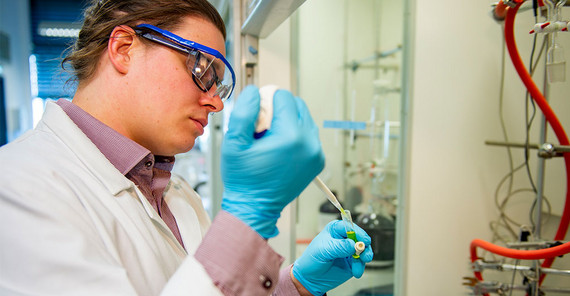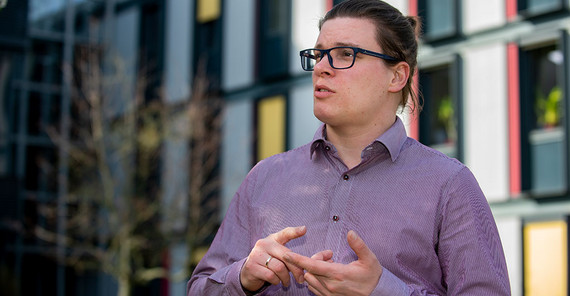Dr. Hartlieb, how long have you been researching antimicrobial substances and why?
I first came across antimicrobial polymers shortly after completing my doctorate. From 2015 to 2017 I was in England, in Prof. Sébastien Perrier’s group in Warwick. Various ideas for antimicrobial materials such as peptides, polymers, and combinations of these classes of substances developed during the work with him. Of course, the topic was not new at the time and various groups have been working on it for 15 years already. We, however, asked ourselves new questions - for example how the microstructure of polymers influences antimicrobial properties.
The topic captivated me because it addressed an important problem: antimicrobial resistance. The growing resistance of bacteria to normal antibiotics is becoming increasingly problematic and the World Health Organization (WHO) has placed this at the top of its list, the keyword here being “hospital germs”. We are experiencing firsthand what happens when there is a pathogen for which there is no antidote. Bacteria, of course, would not spread as rapidly as the Corona virus is currently doing. It is more about hospital environments and people who have a weak immune system, for example elderly people and patients undergoing chemotherapy, suffering from autoimmune diseases or having transplants. At the moment, there is almost always an antibiotic that helps. But if resistance genes continue to spread, the end of the flagpole could soon be reached. In such a “post antibiotic era”, medical procedures would be significantly more dangerous and life expectancy could decrease considerably.
Working on antimicrobial polymers is my contribution to doing something useful for our society. It remains to be seen whether this will work - but we should at least try. That’s why I took the topic with me to set up a junior research group.
What substances are you working on specifically - what can they do and how do they work?
We manufacture water-soluble polymers that attack and destroy bacteria. The model for this are antimicrobial peptides, which our immune system uses to fend off bacteria. The detection works via electrostatic interactions, i.e. via charges. Bacteria are negatively charged, the peptides or our polymers are positive charged and thus attach to bacteria. Since the cells of our body are largely neutral, they are spared.
When the peptide or polymer reaches the bacterium, it disrupts its membrane structure and partially dissolves the membrane, which is fatal to the bacterium. This is a great advantage over conventional antibiotics because the bacterium is hardly able to develop a resistance to this. In principle, that would be possible but the bacterium would have to sacrifice a lot for this, which in turn would reduce its pathogenicity. However, the polymers are not a miracle weapon because they are nowhere near as potent as antibiotics and the selectivity between bacteria and our own cells is often not high enough. That is where our research begins.
Where could these polymers be used?
The goal would be to use them like normal antibiotics, i.e. in the form of a pill or an injection, to fight an infection. The problem is that even if you find a polymer that has all the necessary properties, there are still lengthy approval processes that are also expensive. For this, these materials have to be made significantly better - which is my express goal.
In the meantime, one could think about applications with a lower threshold, for example surface coatings that actively defend themselves against bacterial growth. This is important for implants but also for many medical devices such as catheters, accesses, etc. Antimicrobial polymers could also play a role in wound management. Of course, the materials would then have to be adapted to the specific purpose.
We are not currently working on these applications, but I have various ideas and will also submit research proposals on these topics.
What is the relevance of your research with regard to the Corona virus that, according to the latest information, can apparently survive on plastic surfaces for several days?
There are antimicrobial peptides that are also effective against certain viruses, but I have to admit that I don’t understand enough about viruses at the moment to be able to say whether polymers could do it and how useful this would be in the end. I will be reading about this over the next few weeks while working from home.
What the current crisis shows us is the fragility of our health and how many vulnerable people we have in our society. Even after we have overcome this virus, such situations can occur again. In comparison, antimicrobial resistance is a rather slow process, but so far it can hardly be stopped and thus has an enormous potential to negatively impact our lives.
Which advantages and disadvantages do antimicrobial polymers have, for example with regard to allergies and resistances that might develop due to germicidal substances? Are these aspects also conceivable for the polymers you are working with?
Allergies and intolerances are always a potential risk, of course, but that is also true for conventional antibiotics. For me this is not a knock-out argument. Ideally, I will be able to say more about that in a few years.
The great advantage of polymers is that there is hardly any risk that bacteria will become resistant to them. We can also quickly and specifically change the structure and composition of the systems. The main disadvantage at the moment is the lack of selectivity. In other words, the polymers are too toxic for us. It is also not completely clear how exactly different polymers interact with the membranes, and which structural features are changed in which way. I hope to find answers to these questions.
You have your post doc position with the group of Prof. Böker in the Open Topic Initiative of the University of Potsdam. How have you found your new post and the research opportunities in Potsdam?
I've been here for almost a year now and I am very happy with the postdoc program. I enjoy so much freedom in my research. Prof. Böker is the ideal mentor who offers advice and assists and supports me wherever he can. He also gives me a lot of freedom in terms of the thematic structure of my work and lets me publish on my own. There is nothing left to be desired for a young scientist.
My biggest problem right now is staff. Various applications for the funding of doctoral positions or other human resources have already been submitted and more will follow. In the meantime, various topics for Bachelor or Master theses are available. So, if you have a background in chemistry or biochemistry and are looking for a topic for your thesis, feel free to contact me.
The Researcher
Dr. Matthias Hartlieb studied chemistry at Friedrich Schiller University Jena. Since 2019, he has been a postdoc research fellow in Prof. Alexander Böker’s group at the University of Potsdam.
Mail: mhartliebuuni-potsdampde
This text was published in the university magazine Portal Wissen - Two 2020 „Health“.


